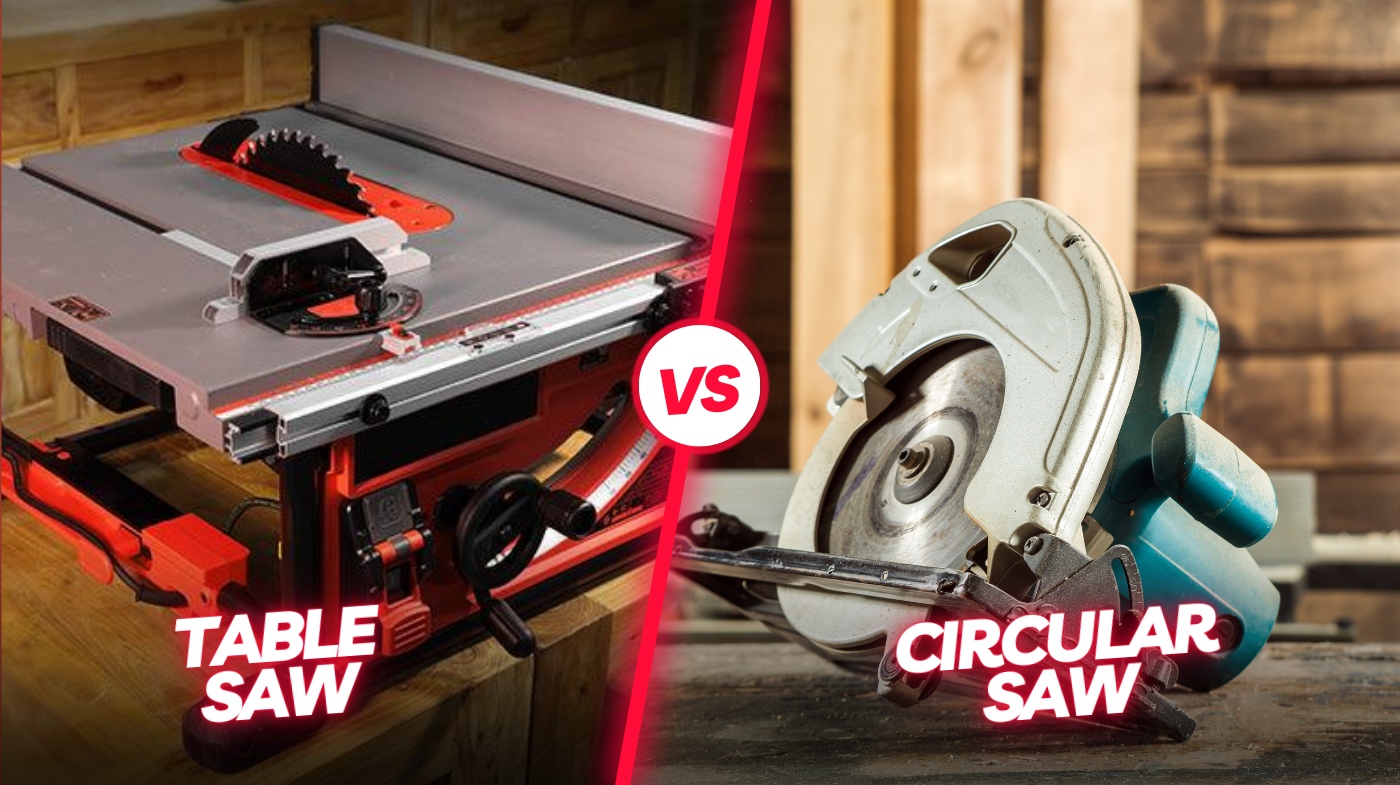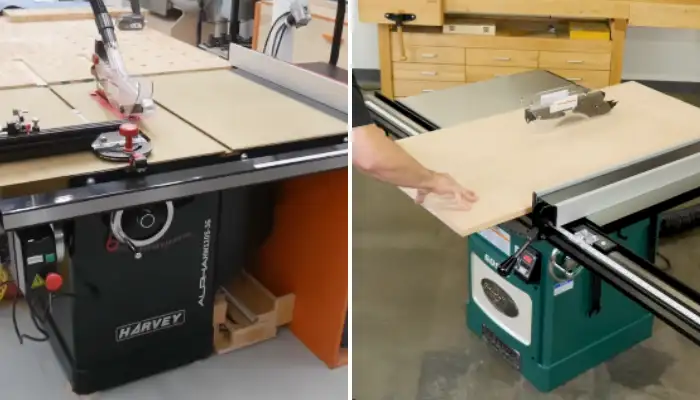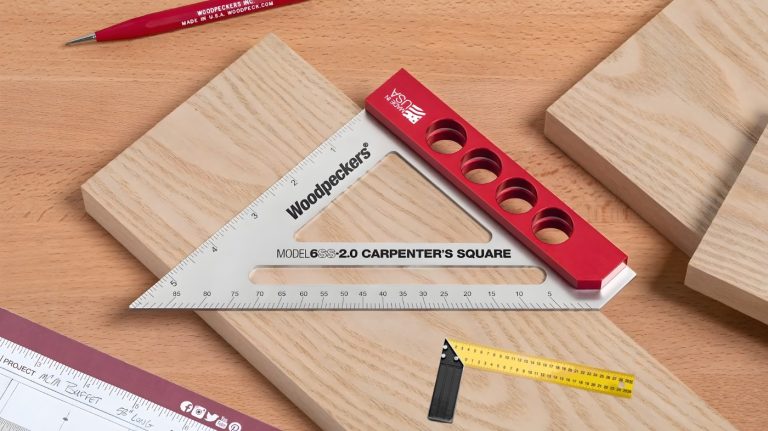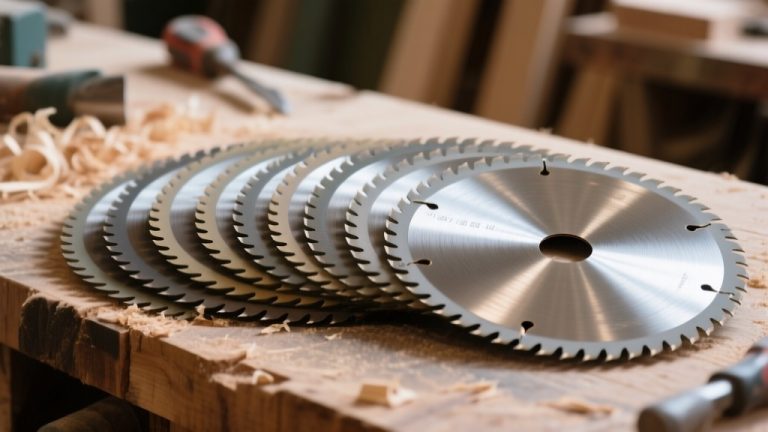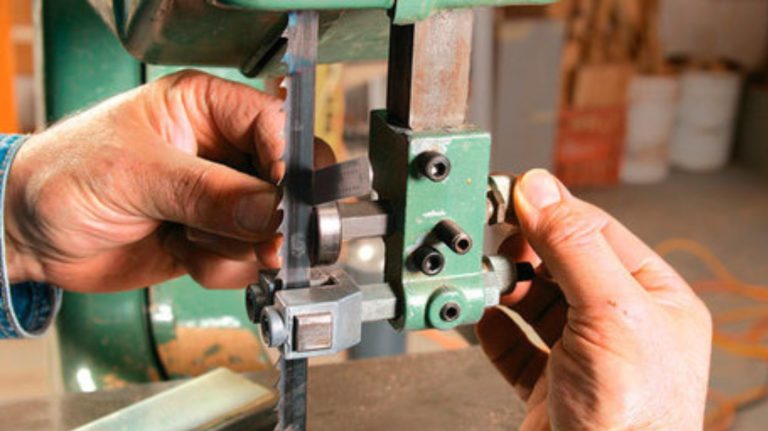Table Saw vs Circular Saw: Key Comparison to Choose Right
You’ll find a circular saw handy for portability and flexible cuts on-site or with irregular materials, though it demands more skill for precision.
A table saw excels in stationary workshops, offering unmatched accuracy, repeatability, and safer operation with fixed fences and advanced safety features.
While table saws cost more upfront, they provide long-term value in precision, whereas circular saws are budget-friendly and versatile. To pick the best fit, consider your workspace, project needs, and skill level—more details follow.
- RACK AND PINION FENCE RAILS – Ensures fence stays parallel to blade for fast smooth, and accurate…
- INTEGRATED FOLDING STAND – Legs quickly fold in to provide portability and convenient storage
- PARALLEL BLADE ALIGNMENT – Available micro-adjustment of blade so that it is parallel to rip fence…
- Powerful 15-amp motor delivers 5 300-RPM for greater speed and faster cuts
- 7-1 4-inch carbide-tipped blade included. Spindle lock for easy blade changes.
- 51° bevel capacity with a positive stop at 45° for a wide variety of cuts
Key Takeaways
- Circular saws are portable and lightweight, ideal for on-site work and tight spaces, unlike bulky, stationary table saws.
- Table saws offer superior accuracy and consistency with fixed blades and fences, making them beginner-friendly for precise cuts.
- Circular saws provide versatile cutting options, including bevel and plunge cuts, while table saws excel at straight, repeatable rip cuts.
- Safety features like blade guards and riving knives enhance table saw safety, whereas circular saws rely on user skill and proper handling.
- Table saws have higher upfront costs but deliver long-term durability, while circular saws are budget-friendly with lower maintenance needs.
Portability and Size Comparison
When comparing portability and size, you’ll find that circular saws outperform table saws in mobility due to their handheld, lightweight design.
Circular saws are compact, easy to carry, and adapt well to various work environments, making them ideal for on-site tasks or smaller workspaces. Their smaller footprint allows them to be used effectively even in tight spaces.
In contrast, table saws are bulky and heavy, requiring a dedicated, stationary setup with significant storage space. Their wide table surface suits large-scale woodworking but limits transportation and field use.
The complex design of table saws, including tables and fences, prioritizes precision over mobility.
Circular saws, with their simple, ergonomic build, allow you to maneuver them in multiple positions and transport them effortlessly between locations, enhancing versatility without the spatial constraints that table saws impose.
Their portability also makes them suitable for plunge cuts and freehand operations that table saws cannot easily perform.
Ease of Use and Operation
Choosing between a table saw and a circular saw greatly impacts your ease of use and operation, especially depending on your skill level and project requirements.
Table saws come mostly ready to use, requiring minimal setup and calibration. Their fixed position and built-in rip fence simplify making straight, precise cuts with better stability and control. You’ll find table saws more beginner-friendly due to integrated safety features and lower error margins.
Additionally, the stationary tool design of table saws allows users to move the workpiece towards the blade for enhanced precision. Table saws are also known for their substantial depth of cut, making them suitable for a wide range of material thicknesses.
In contrast, circular saws demand more preparation—like aligning blades with guides—and higher skill for accurate, consistent cuts. Handheld operation increases the chance of mistakes and accidents, requiring more practice to master.
While circular saws offer quicker blade changes, their manual guidance and lack of fixed fences make them less straightforward to operate compared to table saws.
Versatility and Material Compatibility
You’ll find circular saws excel with diverse materials like tile, metal, and masonry when equipped with specialized blades, while table saws handle hardwoods and sheet goods up to 50 inches wide with precision.
Circular saws are also known for their adjustable blade height and tilting angles, which enhance their versatility on different materials.
Circular saws offer flexible cutting techniques, including plunge and bevel cuts, adapting well to irregular shapes and on-site adjustments. Their portability allows for adaptability in different work environments, making them convenient for varied job sites.
In contrast, table saws deliver consistent rip and crosscuts but require additional jigs or setups for complex angles and limited material thickness.
Material Types Handled
Both table saws and circular saws handle a broad array of materials, from wood and composites to metals and plastics, by utilizing specialized blades designed for each type.
Table saws excel at cutting wood, plywood, MDF, laminate, and veneer with precision, and can handle thin metal sheets and plastics when equipped with the correct blades.
Choosing the appropriate blade kerf, such as thin kerf blades for less powerful saws, enhances cutting efficiency and reduces motor strain. Additionally, the motor power of table saws plays an important role in managing tougher materials with ease.
Circular saws are versatile for framing lumber, plywood, and thin metals like aluminum or mild steel, also accommodating plastics and laminates with specialty blades.
You’ll find carbide-tipped blades common on both, ensuring durability and sharpness. When cutting thicker materials, table saws offer better stability and precision, while circular saws provide portability for on-site work.
Matching blade diameter, arbor size, and RPM ratings with the material type is essential for effective, safe cutting.
Cutting Technique Flexibility
Although table saws provide superior stability and precision for straight and rip cuts, circular saws offer greater cutting technique flexibility with their ability to perform compound, bevel, and plunge cuts.
You can tilt the blade on a circular saw to execute compound cuts or angle it for bevel cuts, which table saws can’t do as easily. Circular saws also allow plunge cuts by starting the blade above the material and lowering it into the workpiece, expanding your cutting options.
However, circular saws may lack the integrated guides of track saws, making proper cutting accuracy more reliant on user skill.
However, circular saws demand more skill to maintain accuracy, often requiring guides or straightedges for precise cuts. Their portability and flexibility make them suitable for job sites where transporting a table saw is impractical.
Table saws excel in repeatability and stability, holding the workpiece firmly for consistent rip cuts. When versatility in cutting angles and portability matter, circular saws outperform table saws despite a steeper learning curve.
Accuracy and Cutting Precision
When it comes to straight-line accuracy, the table saw stands out with its fixed blade and fence system—delivering consistent, repeatable cuts every time. Here’s how it compares:
Straight-Line Cutting Accuracy
Achieving straight-line cutting accuracy hinges on the guidance system each saw employs. Table saws use fixed fences that guarantee parallel alignment, delivering near-perfect, repeatable cuts with minimal setup.
You don’t need to recalibrate fences, which eliminates manual measurement errors and reduces user dependency. Their design is superior for ripping and precise cuts, making them ideal for woodworking projects.
Circular saws, however, rely on external guides like straightedges or track systems to approach table saw precision. When using a circular saw, it is important to measure the distance from the edge of the saw base to the blade for accurate cuts, ensuring that the guide is positioned correctly to achieve straight results Guide Method. Without guides, freehand cuts risk deviation, especially over longer distances.
While track-guided circular saws can match table saw accuracy, they demand precise setup and alignment skills, and minor guide slippage remains a concern. If you prioritize tight-tolerance cuts, such as joinery requiring ±1/32″ accuracy, table saws offer superior stability and consistency.
Circular saws provide versatility on-site but at the cost of increased setup time and skill for comparable straight-line precision. For projects requiring various angled cuts, a miter saw’s rotatable design can offer additional cutting flexibility beyond what circular saws provide.
Consistency and Kerf Width
Since consistent cuts are critical for precision woodworking, understanding how table saws and circular saws handle repeatability and kerf width is essential.
Table saws excel here, offering high repeatability with a stable surface and fence system that guarantees the workpiece moves steadily toward a fixed blade. This setup provides a standard kerf width, enhancing accuracy and uniformity in your cuts.
Additionally, table saws are equipped with fences or stop blocks for repetitive cuts, ensuring uniformity and better suited for large or heavy materials due to sturdy construction and powerful motors repetitive cuts. Their high precision capabilities also allow for a variety of cuts including dados, rabbets, and bevels, which adds to their versatility and accuracy.
Circular saws, however, rely heavily on your skill and steady control, often requiring guide rails to improve consistency. Their kerf width varies more, depending on blade choice, which can affect fit and finish.
While you can adjust blades on both tools, the table saw’s fixed setup simplifies calibration, making it the preferred choice when precise, repeatable kerf widths matter most in your projects.
Safety Features and Considerations
Although both table saws and circular saws are powerful tools, their safety features differ considerably to address specific operational risks. Table saws include blade guards, riving knives, and SawStop mechanisms to prevent kickback and accidental contact.
Circular saws rely on safety rings, micro-adjustments, and proper foot design to enhance control and reduce slippage. Both require proper training, PPE, and a clean workspace.
Starting with a blade guard is essential for protecting fingers from the saw blade. It is also critical to avoid wearing gloves when using a table saw to prevent accidents caused by material catching in the blade.
| Safety Feature | Table Saw | Circular Saw |
|---|---|---|
| Kickback Prevention | Riving Knife, Anti-Kickback Pawls | Limited, some kickback systems |
| Blade Protection | Blade Guard, SawStop Mechanism | Safety Rings |
| Stability | Fixed Table Surface | Proper Foot Design |
| Control Adjustments | Fixed Settings | Micro-Adjustments |
Choosing the Right Saw for Your Projects
How do you determine which saw suits your specific project needs? Consider mobility first: if you work onsite or with large, immovable materials, a circular saw’s portability is essential.
For projects demanding precision and repeatable straight cuts, a table saw’s integrated rip fence and stable platform deliver superior accuracy. Assess material diversity—circular saws handle wood, metal, and concrete by changing blades, whereas table saws excel primarily with wood and plywood.
Also factor in your workspace; a stationary table saw fits well in a dedicated workshop, while circular saws adapt to varied environments. Finally, match the saw to your skill level—table saws offer easier, safer operation for beginners, while circular saws require more experience to achieve consistent, precise cuts without guidance tools.
Additionally, keep in mind that tools with built-in dust collection systems can help maintain a cleaner and safer work area. Choose based on these criteria for ideal results.
Frequently Asked Questions
Can I Use a Circular Saw Blade on a Table Saw?
You can use a circular saw blade on a table saw if the blade’s arbor size matches your saw’s arbor shaft and the RPM rating is compatible. Typically, circular blades are smaller (7-1/4 inches) than standard table saw blades (10 inches), so check for vibration or cutting precision issues.
Confirm the blade is properly seated to avoid accidents, and choose the blade type based on your cutting needs for best results and safety.
Which Saw Is Better for Beginners to Learn Woodworking?
For beginners learning woodworking, you’ll find a tool with built-in safety features and a stable, stationary work surface easier to control and safer. A saw that includes guides for straight, repeatable cuts helps you achieve precision without extensive practice.
While initial investment might be higher, this tool offers consistent accuracy and efficiency. Its design minimizes handling complexity, making it ideal for mastering fundamental cutting techniques effectively and safely.
How Do Blade Sizes Differ Between Table Saws and Circular Saws?
Think of blade sizes as gears in a machine—each must fit perfectly to function smoothly. You’ll find table saws usually use larger blades, mostly 10 inches, sometimes up to 12 inches, with bore sizes of ⅝ or 1 inch.
Circular saws typically use smaller blades, commonly 7-1/4 inches, ranging from 6 to 10 inches, sharing similar bore sizes. Matching blade and bore sizes guarantees safe, efficient cutting performance.
What Are Common Accessories for Enhancing Circular Saw Functionality?
You can enhance your circular saw’s functionality with rip fences and straight edge guides for precise rip and crosscuts. Tracks and rails improve accuracy on large panels, especially when paired with silicone grip tape.
Edge guides and clamps stabilize your material for straight cuts. Don’t forget maintenance accessories like worm drive lubricant and dust collection systems. Various specialized blades and carrying cases also extend your saw’s versatility and lifespan.
Can Table Saws Be Safely Used Outdoors on Job Sites?
Did you know that 75% of job site injuries involve improper equipment setup? You can safely use table saws outdoors by placing them on stable, level surfaces and ensuring dry, well-lit conditions. Always wear protective gear and manage cords to prevent hazards.
Use portable models with dust collection and safety brakes, and protect the saw from weather with tents or canopies. Regular maintenance and clear emergency protocols are essential for safety.
Table or Circular Saw? Let Your Project Decide
You might think a table saw’s bulk and precision make it the obvious champion, yet its lack of portability can turn your workshop into a stationary fortress. Meanwhile, the nimble circular saw promises freedom but demands steady hands and sharp judgment.
Ironically, choosing between them often boils down to whether you want a reliable cage or a wild stallion. In the end, your project’s demands will be the true ruler of your saw choice.
- 24.5 in. of rip capacity for ripping 4×8 plywood or OSB sheets
- Compact size for easy transportation and storage
- Rack & pinion telescoping fence rails make fence adjustments fast, smooth, and accurate
- 5150 RPM motor of DEWALT circular saw delivers power and speed to make the most demanding cuts with…
- High strength and lightweight magnesium shoe of the corded circular saw provides jobsite durability…
- Optimized rubber overmolded comfort grip of the compact circular saw delivers optimal balance and…
Last update on 2025-12-19 / Affiliate links / Images from Amazon Product Advertising API

